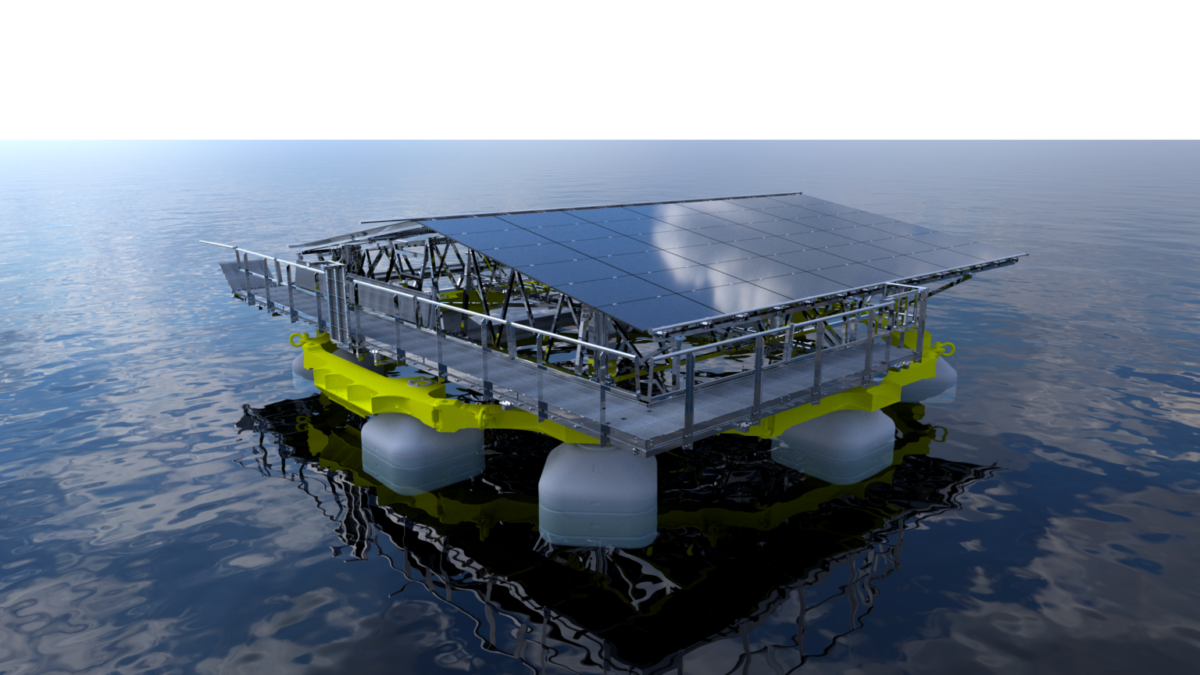From pv magazine Italy
Italian gas contractor Saipem has deployed a new offshore floating solar array near Froya Island in the Norwegian Sea, close to Trondheim.
Saipem's Moss Maritime unit developed the XolarSurf prototype with Norway-based Kystteknikk Maritime Service AS. The system is built to endure waves up to 8 meters high.
“These waves can be found, for example, in much of Southeast Asia, the coastal areas of the Mediterranean, the Gulf of Guinea, or the Middle East,” Moss Maritime CEO Ida Husem told pv magazine. “For locations with more challenging environments, such as the North Sea, we have developed XolarSurf Generation 2, which is based on the same principles as Generation 1, but has a more robust structure. For quieter locations, a scaled-down version of XolarSurf may be applicable.”
The prototype consists consists of floaters, a frame, a PV mounting structure, and electrical equipment such as PV panels, inverters and wiring.
“An island will consist of several individual floaters connected to each other with self-lubricating rotary joints,” Husem said. “The individual floaters are free to rotate relative to each other, causing the island to act like a floating carpet above incoming waves. The size of an island depends on local site conditions and customer requirements. For larger farms, multiple islands are sufficient – the number of floaters per island and the number of islands in a farm can be customized to meet any capacity requirement.”
The installed capacity per platform depends on the size of the floaters, as well as the arrangement, size and capacity of the solar panels.
“The recently launched prototype has a capacity of 35 kW to 45 kW, Husem said. “However, the efficiency of panels is increasing rapidly and typically, and based on the efficiency available today a panel can have a capacity of 700 W, which means a significant increase in the capacity per float already available.”
The companies conducted resistance and stress tests of the float-to-float connector in the lab and full-scale tests of the docking procedure in open waters.
Husem noted that the system can be hybridized with offshore wind turbines, as both projects can share infrastructure for transporting electricity and joint O&M activities. She said the wind-solar duo offers a more balanced production profile. On sunny days, wind is often limited, while on windy days, the sun can be limited, she explained.
The prototype is the result of years of development, design, lab testing of models and components, and full-scale marine testing by Saipem, Moss Maritime, and Norway’s Equinor.
“We have been in contact with several potential customers over the past few years, some of whom we are currently evaluating future collaborations with us,” said Husem.
Husem noted that the aquaculture industry is well-suited for the proposed platform, as it relies heavily on diesel generators, with most of its energy consumption going toward fish feeding. She added that the platform could also provide electricity to remote areas or serve as a hybrid solution with offshore wind energy.
The testing phase will last one year. Husem emphasized that, alongside testing, development is underway on XolarSurf Generation 1, designed for semi-hostile environments, and Generation 2 for more extreme conditions. Pilot projects of 0.5 to 1 MW are planned as part of the transition to a commercial product.
Moss Maritime, a 100% subsidiary of Saipem, owns the XolarSurf technology and is currently responsible for all offshore floating solar development within Saipem.
This content is protected by copyright and may not be reused. If you want to cooperate with us and would like to reuse some of our content, please contact: editors@pv-magazine.com.



By submitting this form you agree to pv magazine using your data for the purposes of publishing your comment.
Your personal data will only be disclosed or otherwise transmitted to third parties for the purposes of spam filtering or if this is necessary for technical maintenance of the website. Any other transfer to third parties will not take place unless this is justified on the basis of applicable data protection regulations or if pv magazine is legally obliged to do so.
You may revoke this consent at any time with effect for the future, in which case your personal data will be deleted immediately. Otherwise, your data will be deleted if pv magazine has processed your request or the purpose of data storage is fulfilled.
Further information on data privacy can be found in our Data Protection Policy.